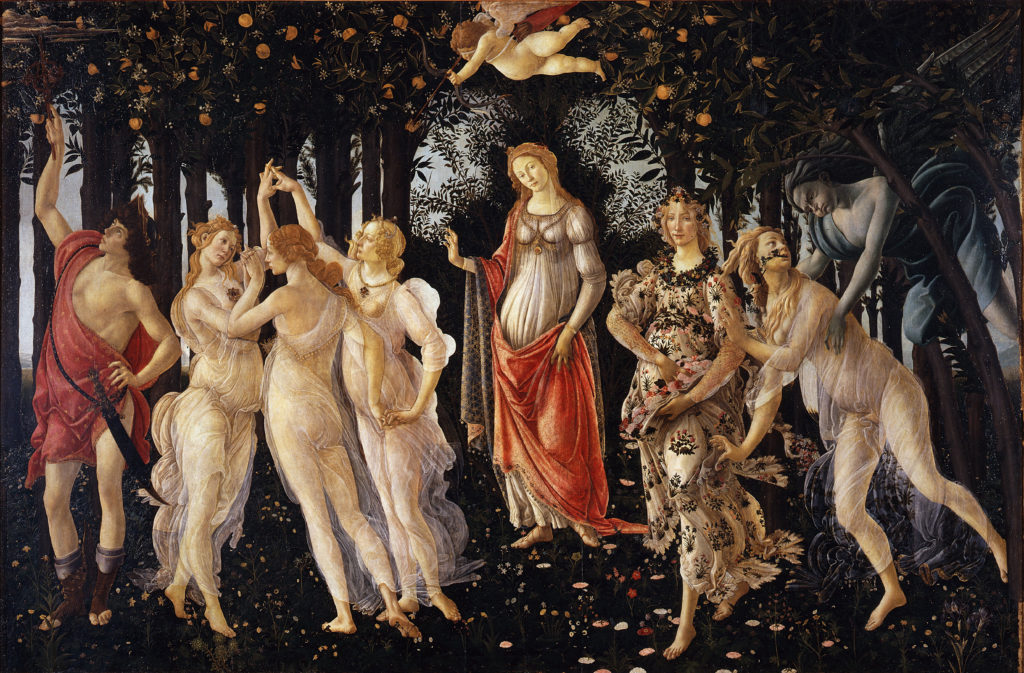
Renaissance art marks a cultural rebirth at the close of the Middle Ages and rise of the Modern world, known for its focus on the beauty of the natural world, human emotion, and in-depth perspective. Originating in Italy in the 14th century and lasting until the 17th century, it spread across Europe, with each region developing its distinct style. This period is characterized by significant achievements in painting, sculpture, and architecture, as artists revisited Classical sources and humanist philosophies, emphasizing harmony, proportion, and disciplined use of geometry.
Key Features of Renaissance Art:
- Humanism: The study of Classical texts led to a new emphasis on human potential and achievements, reflected in more lifelike, emotionally expressive, and individualized portrayals of subjects.
- Perspective: Artists developed linear perspective, allowing them to create the illusion of depth and space on a flat surface, revolutionizing how scenes were depicted.
- Realism & Emotion: Moving away from the stylized forms of the medieval period, Renaissance artists focused on creating realistic scenes and figures, imbued with emotion and set against detailed, naturalistic backgrounds.
- Use of Light: Chiaroscuro, the technique of using light and shadow to model forms, became prominent, adding a dramatic effect and sense of volume to paintings.
- Classical Influences: Drawing inspiration from ancient Rome and Greece, art featured Greco-Roman gods and goddesses, architectural elements, and philosophical themes.
Notable Artists and Works:
- Leonardo da Vinci (1452–1519) – A polymath whose interests spanned various fields, Leonardo is known for his exquisite paintings such as “The Last Supper” and “Mona Lisa.” His detailed studies of human anatomy, nature, and engineering made significant contributions to art and science.
- Michelangelo Buonarroti (1475–1564) – Celebrated for his mastery in sculpture, painting, and architecture, Michelangelo’s notable works include the statues of “David” and “Pietà,” as well as the Sistine Chapel ceiling frescoes in Vatican City.
- Raphael (Raffaello Sanzio da Urbino) (1483–1520) – Known for his clarity of form and ease of composition, Raphael’s most famous works include “The School of Athens” in the Vatican’s Stanza della Segnatura and numerous beautiful Madonnas.
- Donatello (c. 1386–1466) – One of the earliest Renaissance artists to emphasize realistic human anatomy in sculpture. His works, including the bronze “David” and “Gattamelata,” demonstrated a profound understanding of emotion.
- Sandro Botticelli (c. 1445–1510) – Botticelli’s paintings are celebrated for their flowing lines and graceful forms, as seen in “The Birth of Venus” and “Primavera,” which reflect the Renaissance’s fascination with classical mythology.
- Titian (Tiziano Vecelli) (c. 1488–1576) – A leading figure of the Venetian school, Titian was known for his vibrant color palette and expressive brushwork. His masterpieces include “Assumption of the Virgin” and “Venus of Urbino.”
- Albrecht Dürer (1471–1528) – A German artist whose high-quality woodcuts and engravings, such as “Melencolia I” and “Knight, Death, and the Devil,” revolutionized printmaking. Dürer was also a skilled painter and theorist.
- Jan van Eyck (c. 1390–1441) – A Flemish painter known for his detailed landscapes and portraiture, van Eyck is often credited with the invention of oil painting. His most famous work is “The Arnolfini Portrait.”
- Hieronymus Bosch (c. 1450–1516) – A Dutch painter known for his imaginative and complex works filled with symbolic narratives, as seen in “The Garden of Earthly Delights.”
- Filippo Brunelleschi (1377–1446) – Not a painter but an architect and engineer, Brunelleschi’s contributions to Renaissance art include the development of linear perspective and the design of the dome of the Florence Cathedral, which had a profound impact on Renaissance aesthetics.
Impact and Legacy: The Renaissance period laid the groundwork for the development of modern Western art, influencing countless artists and movements that followed. Its emphasis on observation, realism, and the use of scientific methods in art had a lasting impact, shaping the future of art for centuries to come. Renaissance art remains a pinnacle of human achievement, celebrated for its advancement of artistic techniques and deep exploration of human nature and the natural world.